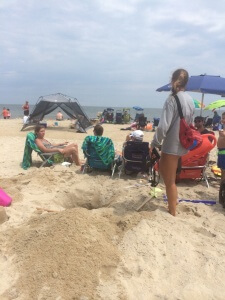Whenever you go to the beach you are sure to see people of all ages digging in the sand. Digging a hole is normally viewed as a chore however at the beach it suddenly becomes a fun way to pass the time. I have come to realize that most people have no idea about how dangerous digging deep holes in the sand can be. Lifeguards know that these holes—even fairly shallow ones—can collapse and kill. They monitor digging holes and will inform diggers that the sand can be a serious hazard. Lots of people dig holes or tunnels in the sand, but they don’t know their holes can quickly cave in and trap those inside. The rule is simple and straightforward: you can dig holes on the beach as long as they only take up a small area and are no deeper than the knees of the smallest person in the group. There is absolutely no tunneling allowed. Never leave your hole unattended and always fill it back in so it isn’t a hazard to others.
Seven summers ago in Ocean City, an 11-year-old boy attempted to dig a tunnel between two holes. The tunnel collapsed and he was buried alive, headfirst, with only his feet exposed. There was nothing he could do to save himself. The more he struggled the tighter packed the sand around him became. Lucky for him a girl noticed the trouble and alerted a family member who began efforts to free the child from the sand that not only was trapping him but also taking his life. As several minutes passed, the situation became frenzied when the mom screamed for help.
The scream of terror brought several nearby beach patrons to assist with unearthing the trapped child, however, these efforts were making little progress and in actuality were making the situation worse, which is usually the case with a bystander response. As the first lifeguards arrived on the scene they immediately went to work and with a more organized effort were able to recover the lifeless body of the boy. This is a skill that surf rescue technicians (SRTs) are trained in and practice each season for emergencies such as these. They performed CPR and this story had a happy ending. In fact we still keep in touch with the family who remains forever grateful.
For some hole diggers, the story can have a deadly ending. We try to tell people about the dangers of digging holes in the sand before their, often-intricate, pit digging plans get too far underway. There is something about a day at the beach that makes people want to dig and most people don’t realize the dangers. Digging a shallow hole to lie down in and get covered up for a picture is funny and safe. But anything deeper than the knee is not. Out on the beach digging holes has become just another part of the vacation like looking for sand crabs or eating fries on the boardwalk. Our SRTs always do their best to monitor the different situations on their beaches, but on a day when the water is busy and the beach is crowded with umbrellas, diggers can make dangerous amounts of progress in the sand, not even realizing the potential for danger, before they are asked to fill in their holes.
Facts about the dangers of digging deep holes in the sand
SRTs are often asked by hole diggers why deep holes are not allowed. Let us review the facts. Deep holes are dangerous just about anywhere they are found and people usually try to avoid falling into them. Sand holes are particularly dangerous because they can collapse on the people digging them. Also, the vacation-oriented mindset of hole diggers clouds judgment, and people tend to underestimate the possible dangers of jumping in and out of a giant sandpit. Many times people want to get their picture taken in the hole that they dug not realizing that at any given moment the sand can cave in around them. Once a person is buried in the sand it is very difficult (boarding upon nearly impossible) to dig them out and have a positive outcome.
Sand shifts back into place even as people try to move the sand off of a trapped victim. Interviewing several people who attempted to help the 11-year-old boy referred to in the above Ocean City emergency confirmed that this was exactly what was happening to them. As they feverishly attempted to remove the sand that was trapping the boy, more sand just as quickly took its place. One might be amazed that it would take 40 people 30 minutes to free a buried victim. Just as a person can drown in a small amount of water it does not take a very deep hole to trap a child and once trapped due to the nature and instability of sand holes a person could parish before being freed Hence the rule that the hole may only be as deep as the knee of the smallest person in the group of people digging the hole.
The danger is real
I have heard some people say that people being buried alive under the sand is an old wives tale that lifeguards use to scare people into obeying a rule.Let’s look at the startling statistics.
- More than several dozen young people have been killed over the last decade on beaches in the United States when their hole or sand tunnel collapsed on them.
- Harvard researcher, Bradley Maron, who has been tracking sand hole collapses worldwide for the past decade says that 60 percent have been fatal.
- When you look at sand hole collapses worldwide the number dramatically increases and if you look at entrapments that do not end in the death of the trapped individual, the statistics would report hundreds each year.
Interestingly, people always ask about sharks, which never have been a problem in Ocean City. However, national statistics comparing sand hole collapses to shark attacks confirms that you are far more likely to experience a sand hole collapse than a shark attack. A person has a 1 in 3,748,067 chance of a shark attack fatality. So instead of asking every lifeguard how many shark attacks there were this year, people should ask, how many sand hole collapses occurred.
It seems unbelievable that a vacation could end so tragically, but it does happen. Use common sense and keep your hole digging to a safe depth. Remember, if you do dig a hole, never leave it unattended and make sure that you fill it in before you leave for the day.

A gentle reminder
As our dunes are recovering from this past winter’s storm and trying to become more substantial, the dune grasses are flourishing. We are finding that children are being drawn to play in the dunes and dig. Although this has never been allowed we want to urge parents and beach patrons to stay off the dunes to allow them to grow and continue to protect our beach.
The Ocean City beach has one of the cleanest, finest sand you will find anywhere. Enjoy it, but please do so in a safe manner. One thing that you can always do to remain safe is limit beach activity to a time when lifeguards are on duty. Remember to always keep your feet in the sand until the lifeguard’s in the stand; it could safe a life, yours!
.



[…] and then fill the hole with water. The hole provides fun for kids to play with. The goal of the goal digging contest is to dig the deepest hole. Whoever manages to dig the deepest hole a certain time frame, […]